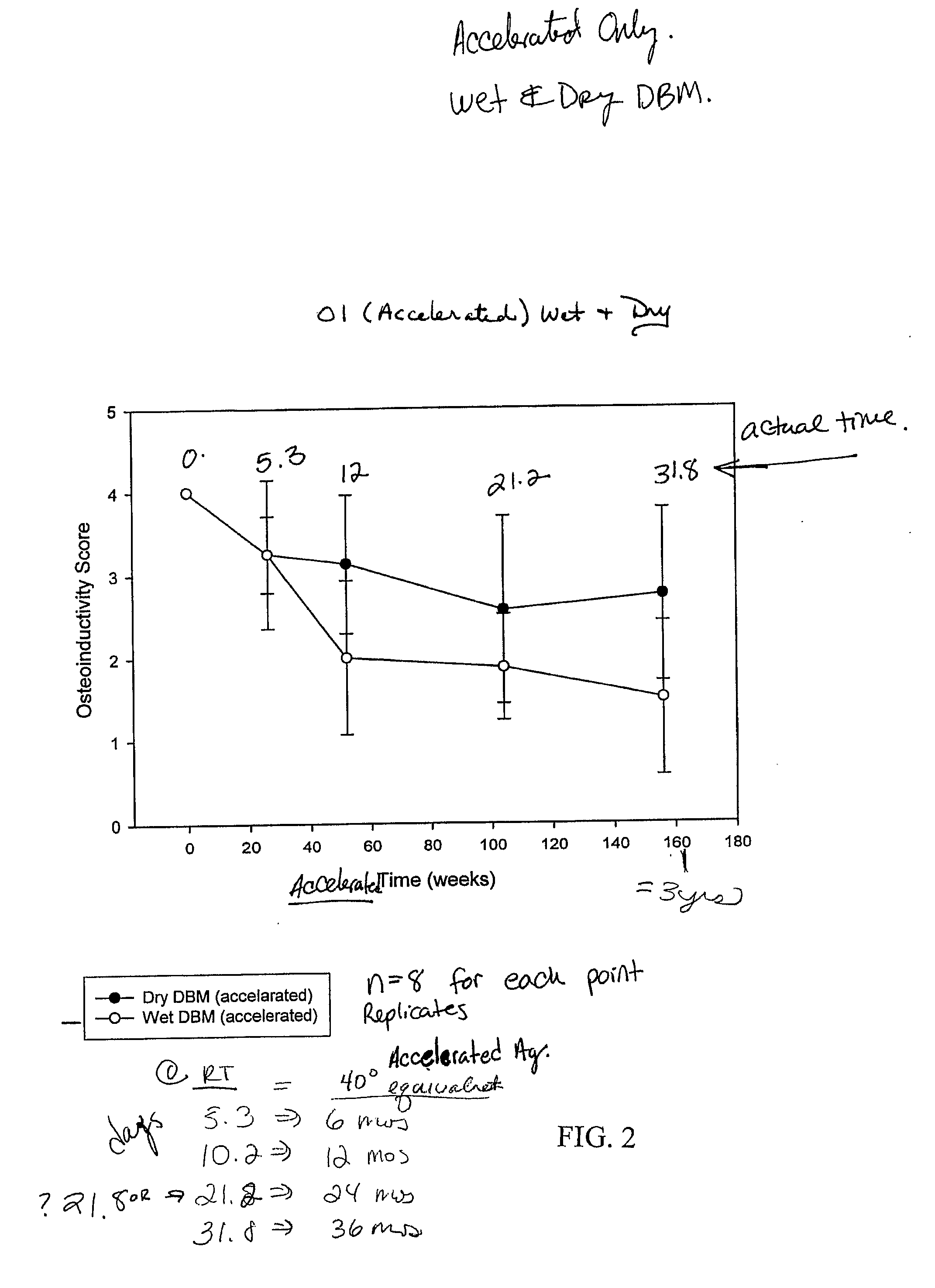Stabilized bone graft
a stabilizing bone and graft technology, applied in the field of stabilizing bone grafts, can solve the problems of dbm compositions with a longer shelf life and factors responsible for osteoinductivity being susceptible to degradation, and achieve the effects of stable dbm compositions, reduced degradation of dbm factors, and stable dbm compositions
- Summary
- Abstract
- Description
- Claims
- Application Information
AI Technical Summary
Benefits of technology
Problems solved by technology
Method used
Image
Examples
example 1
Preparing Demineralized Bone Matrix (DBM)
[0089] DBM may be prepared using any method or technique known in the art (see Russell et al. Orthopedics 22(5):524-531, May 1999; incorporated herein by reference). The following is an exemplary procedure for preparing demineralized bone derived from Glowacki et al. “Demineralized Bone Implants”Clinics in Plastic Surgery 12(2):233-241, April 1985, which is incorporated herein by reference. Bones or bone fragments from donors are cleaned to remove any adherent periosteum, muscle, connective tissue, tendons, ligaments, and cartilage. Cancellous bone may be separated from dense cortical bone and processed as large pieces. Cortical bone may be cut into small pieces to improve the efficiency of subsequent washes and extractions. Denser bone from larger animals may need to be frozen and hammered in order to produce chips less than 1 cm. The resulting pieces of bone are thoroughly washed with cold, deionized water to remove marrow and soft tissue....
example 2
Another Method of Preparing DBM.
[0094] DBM may be prepared using any method or techniques known in the art (See Russell et al Orthopedics 22(5):524-53 1, May 1999; incorporated herein by reference).
[0095] Demineralized bone matrix was prepared from long bones. The diaphyseal region was cleaned of any adhering soft tissue and then ground in a mill. Ground material was sieved to yield a powder with particles approximately 100 μm to 500 μm in diameter. The particulate bone was demineralized to less than about 1% (by weight) residual calcium using a solution of Triton X-100 (Sigma Chemical Company, St Louis, Mo.) and 0.6N HCl at room temperature followed by a solution of fresh 0.6N HCl. The powder material was rinsed with deionized water until the pH was greater than 3.0. It then was soaked in 70% ethanol and freeze-dried to less than 5% residual moisture.
example 3
In Vitro Assessment of pH-stabilized DBM
[0096] Samples of pH stabilized DBM with or without stabilizing agents (or various concentrations and / or formulations of stabilizing agents) are prepared and incubated with serum or individual enzymes (e.g., papain) in PBS buffer (pH 7.4) and incubated at 37° C. for 0.5, 1, 2, 4, 8, and 24 hours Samples are then extracted to determine the concentrations of growth factors and other matrix proteins as outlined in Ueland et. al. (“Increased cortical bone content of insulin-like growth factors in acromegalic patients”J. Clin. Endocrinol. Metab. 1999 January; 84(1):123-7; incorporated herein by reference). Samples are prepared for native and denaturing SDS gel electrophoresis followed by Western blot analysis or Western Ligand blotting as described in Ueland et al. (1999) and incorporated herein by reference (Ueland et al “Increased cortical bone content of insulin-like growth factors in acromegalic patients”J Clin Endocrinol Metab 1999 January; 8...
PUM
| Property | Measurement | Unit |
|---|---|---|
| temperature | aaaaa | aaaaa |
| pH | aaaaa | aaaaa |
| size | aaaaa | aaaaa |
Abstract
Description
Claims
Application Information
 Login to View More
Login to View More - R&D
- Intellectual Property
- Life Sciences
- Materials
- Tech Scout
- Unparalleled Data Quality
- Higher Quality Content
- 60% Fewer Hallucinations
Browse by: Latest US Patents, China's latest patents, Technical Efficacy Thesaurus, Application Domain, Technology Topic, Popular Technical Reports.
© 2025 PatSnap. All rights reserved.Legal|Privacy policy|Modern Slavery Act Transparency Statement|Sitemap|About US| Contact US: help@patsnap.com



